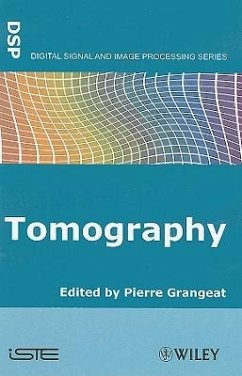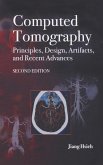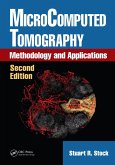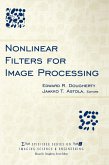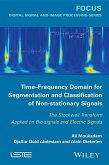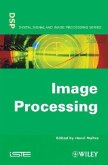Tomography
Herausgeber: Grangeat, Pierre
Tomography
Herausgeber: Grangeat, Pierre
- Gebundenes Buch
- Merkliste
- Auf die Merkliste
- Bewerten Bewerten
- Teilen
- Produkt teilen
- Produkterinnerung
- Produkterinnerung
The principle of tomography is to explore the structure and composition of objects non-destructively along spatial and temporal dimensions, using penetrating radiation, such as X- and gamma-rays, or waves, such as electromagnetic and acoustic waves. Based on computer-assisted image reconstruction, tomography provides maps of parameters that characterize the emission of the employed radiation or waves, or their interaction with the examined objects, for one or several cross-sections. Thus, it gives access to the inner structure of inert objects and living organisms in their full complexity. In…mehr
Andere Kunden interessierten sich auch für
![Computed Tomography Principles, Design, Artifacts, and Recent Advances Computed Tomography Principles, Design, Artifacts, and Recent Advances]() Jiang HsiehComputed Tomography Principles, Design, Artifacts, and Recent Advances144,99 €
Jiang HsiehComputed Tomography Principles, Design, Artifacts, and Recent Advances144,99 €![Spectral, Photon Counting Computed Tomography Spectral, Photon Counting Computed Tomography]() Spectral, Photon Counting Computed Tomography189,99 €
Spectral, Photon Counting Computed Tomography189,99 €![Microcomputed Tomography Microcomputed Tomography]() Stuart R StockMicrocomputed Tomography161,99 €
Stuart R StockMicrocomputed Tomography161,99 €![Digital Color Image Processing Digital Color Image Processing]() Andreas KoschanDigital Color Image Processing210,99 €
Andreas KoschanDigital Color Image Processing210,99 €![Nonlinear Filters for Image Processing Nonlinear Filters for Image Processing]() Edward R DoughertyNonlinear Filters for Image Processing210,99 €
Edward R DoughertyNonlinear Filters for Image Processing210,99 €![Time-Frequency Domain for Segmentation and Classification of Non-stationary Signals Time-Frequency Domain for Segmentation and Classification of Non-stationary Signals]() Ali MoukademTime-Frequency Domain for Segmentation and Classification of Non-stationary Signals170,99 €
Ali MoukademTime-Frequency Domain for Segmentation and Classification of Non-stationary Signals170,99 €![Image Processing Image Processing]() Image Processing212,99 €
Image Processing212,99 €-
-
-
The principle of tomography is to explore the structure and composition of objects non-destructively along spatial and temporal dimensions, using penetrating radiation, such as X- and gamma-rays, or waves, such as electromagnetic and acoustic waves. Based on computer-assisted image reconstruction, tomography provides maps of parameters that characterize the emission of the employed radiation or waves, or their interaction with the examined objects, for one or several cross-sections. Thus, it gives access to the inner structure of inert objects and living organisms in their full complexity. In this book, multidisciplinary specialists explain the foundations and principles of tomographic imaging and describe a broad range of applications. The content is organized in five parts, which are dedicated to image reconstruction, microtomography, industrial tomography, morphological medical tomography and functional medical tomography.
Hinweis: Dieser Artikel kann nur an eine deutsche Lieferadresse ausgeliefert werden.
Hinweis: Dieser Artikel kann nur an eine deutsche Lieferadresse ausgeliefert werden.
Produktdetails
- Produktdetails
- Verlag: Wiley
- Seitenzahl: 432
- Erscheinungstermin: 1. Oktober 2009
- Englisch
- Abmessung: 238mm x 162mm x 30mm
- Gewicht: 805g
- ISBN-13: 9781848210998
- ISBN-10: 184821099X
- Artikelnr.: 28222263
- Herstellerkennzeichnung
- Libri GmbH
- Europaallee 1
- 36244 Bad Hersfeld
- gpsr@libri.de
- Verlag: Wiley
- Seitenzahl: 432
- Erscheinungstermin: 1. Oktober 2009
- Englisch
- Abmessung: 238mm x 162mm x 30mm
- Gewicht: 805g
- ISBN-13: 9781848210998
- ISBN-10: 184821099X
- Artikelnr.: 28222263
- Herstellerkennzeichnung
- Libri GmbH
- Europaallee 1
- 36244 Bad Hersfeld
- gpsr@libri.de
Pierre Grangeat (Telecommunication Engineer, Ph.D., IEEE Senior Member) is a Research Director at CEA, LETI, MINATEC, in Grenoble, France. His field of research covers information processing for biomedical technologies.
Preface xvii
Notation xxi
Chapter 1. Introduction to Tomography 1
Pierre GRANGEAT
1.1. Introduction 1
1.2. Observing contrasts 2
1.3. Localization in space and time 7
1.4. Image reconstruction 9
1.5. Application domains 12
1.6. Bibliography 17
PART 1. IMAGE RECONSTRUCTION 21
Chapter 2. Analytical Methods 23
Michel DEFRISE and Pierre GRANGEAT
2.1. Introduction 23
2.2. 2D Radon transform in parallel-beam geometry 25
2.3. 2D Radon transform in fan-beam geometry 32
2.4. 3D X-ray transform in parallel-beam geometry 37
2.5. 3D Radon transform 40
2.6. 3D positron emission tomography 42
2.7. X-ray tomography in cone-beam geometry 46
2.8. Dynamic tomography 54
2.9. Bibliography . 58
Chapter 3. Sampling Conditions in Tomography 63
Laurent DESBAT and Catherine MENNESSIER
3.1. Sampling of functions in R6¿ 3
3.2. Sampling of the 2D Radon transform 71
3.3. Sampling in 3D tomography 79
3.4. Bibliography 85
Chapter 4. Discrete Methods 89
Habib BENALI and Françoise PEYRIN
4.1. Introduction 89
4.2. Discrete models 90
4.3. Algebraic methods 92
4.4. Statistical methods 99
4.5. Example of tomographic reconstruction 110
4.6. Discussion and conclusion 110
4.7. Bibliography 112
PART 2. MICROTOMOGRAPHY 117
Chapter 5. Tomographic Microscopy 119
Yves USSON and Catherine SOUCHIER
5.1. Introduction 119
5.2. Projection tomography in electron microscopy 120
5.3. Tomography by optical sectioning 121
5.4. 3D data processing, reconstruction and analysis 129
5.5. Bibliography 138
Chapter 6. Optical Tomography 141
Christian DEPEURSINGE
6.1. Introduction 141
6.2. Interaction of light with matter 142
6.3. Propagation of photons in diffuse media 150
6.4. Optical tomography methods 164
6.5. Optical tomography in highly diffuse media 181
6.6. Bibliography 190
Chapter 7. Synchrotron Tomography 197
Anne-Marie CHARVET and Françoise PEYRIN
7.1. Introduction 197
7.2. Synchrotron radiation 197
7.3. Quantitative tomography 202
7.4. Microtomography using synchrotron radiation 206
7.5. Extensions 210
7.6. Conclusion 211
7.7. Bibliography 212
PART 3. INDUSTRIAL TOMOGRAPHY 215
Chapter 8. X-ray Tomography in Industrial Non-destructive Testing 217
Gilles PEIX, Philippe DUVAUCHELLE and Jean-Michel LETANG
8.1. Introduction 217
8.2. Physics of the measurement 218
8.3. Sources of radiation 219
8.4. Detection 220
8.5. Reconstruction algorithms and artifacts 223
8.6. Applications 224
8.7. Conclusion 235
8.8. Bibliography 236
Chapter 9. Industrial Applications of Emission Tomography for Flow
Visualization 239
Samuel LEGOUPIL and Ghislain PASCAL
9.1. Industrial applications of emission tomography 239
9.2. Examples of applications 242
9.3. Physical model of data acquisition 247
9.4. Definition and characterization of a system 252
9.5. Conclusion 255
9.6. Bibliography 255
PART 4.MORPHOLOGICAL MEDICAL TOMOGRAPHY 257
Chapter 10. Computed Tomography 259
Jean-Louis AMANS and Gilbert FERRETTI
10.1. Introduction 259
10.2. Physics of helical tomography 265
10.3. Applications of volume CT 272
10.4. Conclusion 279
10.5. Bibliography 280
Chapter 11. Interventional X-ray Volume Tomography 287
Michael GRASS, RégisGUILLEMAUD and Volker RASCHE
11.1. Introduction 287
11.2. Example of 3D angiography 290
11.3. Clinical examples 297
11.4. Conclusion 302
11.5. Bibliography 303
Chapter 12. Magnetic Resonance Imaging 307
André BRIGUET and Didier REVEL
12.1. Introduction 307
12.2. Nuclear paramagnetism and its measurement 308
12.3. Spatial encoding of the signal and image reconstruction 312
12.4. Contrast factors and examples of applications 318
12.5. Tomography or volumetry? 323
12.6. Bibliography 323
PART 5. FUNCTIONAL MEDICAL TOMOGRAPHY 327
Chapter 13. Single Photon Emission Computed Tomography 329
Irène BUVAT, Jacques DARCOURT and Philippe FRANKEN
13.1. Introduction 329
13.2. Radiopharmaceuticals 330
13.3. Detector 331
13.4. Image reconstruction 336
13.5. Example of myocardial SPECT 343
13.6. Conclusion 346
13.7. Bibliography 348
Chapter 14. Positron Emission Tomography 351
Michel DEFRISE and Régine TRÉBOSSEN
14.1. Introduction 351
14.2. Data acquisition 353
14.3. Data processing 363
14.4. Research and clinical applications of PET 370
14.5. Conclusion 373
14.6. Bibliography 374
Chapter 15. Functional Magnetic Resonance Imaging 377
Christoph SEGEBARTH andMichel DÉCORPS
15.1. Introduction 377
15.2. Functional MRI of cerebrovascular responses 378
15.3. fMRI of BOLD contrasts 380
15.4. Different protocols 383
15.5. Bibliography 389
Chapter 16. Tomography of Electrical Cerebral Activity in Magneto- and
Electro-encephalography 393
Line Garnero
16.1. Introduction 393
16.2. Principles of MEG and EEG 394
16.3. Imaging of electrical activity of the brain based on MEG and EEG
signals 398
16.4. Conclusion 407
16.5. Bibliography 408
List of Authors 411
Index 417
Notation xxi
Chapter 1. Introduction to Tomography 1
Pierre GRANGEAT
1.1. Introduction 1
1.2. Observing contrasts 2
1.3. Localization in space and time 7
1.4. Image reconstruction 9
1.5. Application domains 12
1.6. Bibliography 17
PART 1. IMAGE RECONSTRUCTION 21
Chapter 2. Analytical Methods 23
Michel DEFRISE and Pierre GRANGEAT
2.1. Introduction 23
2.2. 2D Radon transform in parallel-beam geometry 25
2.3. 2D Radon transform in fan-beam geometry 32
2.4. 3D X-ray transform in parallel-beam geometry 37
2.5. 3D Radon transform 40
2.6. 3D positron emission tomography 42
2.7. X-ray tomography in cone-beam geometry 46
2.8. Dynamic tomography 54
2.9. Bibliography . 58
Chapter 3. Sampling Conditions in Tomography 63
Laurent DESBAT and Catherine MENNESSIER
3.1. Sampling of functions in R6¿ 3
3.2. Sampling of the 2D Radon transform 71
3.3. Sampling in 3D tomography 79
3.4. Bibliography 85
Chapter 4. Discrete Methods 89
Habib BENALI and Françoise PEYRIN
4.1. Introduction 89
4.2. Discrete models 90
4.3. Algebraic methods 92
4.4. Statistical methods 99
4.5. Example of tomographic reconstruction 110
4.6. Discussion and conclusion 110
4.7. Bibliography 112
PART 2. MICROTOMOGRAPHY 117
Chapter 5. Tomographic Microscopy 119
Yves USSON and Catherine SOUCHIER
5.1. Introduction 119
5.2. Projection tomography in electron microscopy 120
5.3. Tomography by optical sectioning 121
5.4. 3D data processing, reconstruction and analysis 129
5.5. Bibliography 138
Chapter 6. Optical Tomography 141
Christian DEPEURSINGE
6.1. Introduction 141
6.2. Interaction of light with matter 142
6.3. Propagation of photons in diffuse media 150
6.4. Optical tomography methods 164
6.5. Optical tomography in highly diffuse media 181
6.6. Bibliography 190
Chapter 7. Synchrotron Tomography 197
Anne-Marie CHARVET and Françoise PEYRIN
7.1. Introduction 197
7.2. Synchrotron radiation 197
7.3. Quantitative tomography 202
7.4. Microtomography using synchrotron radiation 206
7.5. Extensions 210
7.6. Conclusion 211
7.7. Bibliography 212
PART 3. INDUSTRIAL TOMOGRAPHY 215
Chapter 8. X-ray Tomography in Industrial Non-destructive Testing 217
Gilles PEIX, Philippe DUVAUCHELLE and Jean-Michel LETANG
8.1. Introduction 217
8.2. Physics of the measurement 218
8.3. Sources of radiation 219
8.4. Detection 220
8.5. Reconstruction algorithms and artifacts 223
8.6. Applications 224
8.7. Conclusion 235
8.8. Bibliography 236
Chapter 9. Industrial Applications of Emission Tomography for Flow
Visualization 239
Samuel LEGOUPIL and Ghislain PASCAL
9.1. Industrial applications of emission tomography 239
9.2. Examples of applications 242
9.3. Physical model of data acquisition 247
9.4. Definition and characterization of a system 252
9.5. Conclusion 255
9.6. Bibliography 255
PART 4.MORPHOLOGICAL MEDICAL TOMOGRAPHY 257
Chapter 10. Computed Tomography 259
Jean-Louis AMANS and Gilbert FERRETTI
10.1. Introduction 259
10.2. Physics of helical tomography 265
10.3. Applications of volume CT 272
10.4. Conclusion 279
10.5. Bibliography 280
Chapter 11. Interventional X-ray Volume Tomography 287
Michael GRASS, RégisGUILLEMAUD and Volker RASCHE
11.1. Introduction 287
11.2. Example of 3D angiography 290
11.3. Clinical examples 297
11.4. Conclusion 302
11.5. Bibliography 303
Chapter 12. Magnetic Resonance Imaging 307
André BRIGUET and Didier REVEL
12.1. Introduction 307
12.2. Nuclear paramagnetism and its measurement 308
12.3. Spatial encoding of the signal and image reconstruction 312
12.4. Contrast factors and examples of applications 318
12.5. Tomography or volumetry? 323
12.6. Bibliography 323
PART 5. FUNCTIONAL MEDICAL TOMOGRAPHY 327
Chapter 13. Single Photon Emission Computed Tomography 329
Irène BUVAT, Jacques DARCOURT and Philippe FRANKEN
13.1. Introduction 329
13.2. Radiopharmaceuticals 330
13.3. Detector 331
13.4. Image reconstruction 336
13.5. Example of myocardial SPECT 343
13.6. Conclusion 346
13.7. Bibliography 348
Chapter 14. Positron Emission Tomography 351
Michel DEFRISE and Régine TRÉBOSSEN
14.1. Introduction 351
14.2. Data acquisition 353
14.3. Data processing 363
14.4. Research and clinical applications of PET 370
14.5. Conclusion 373
14.6. Bibliography 374
Chapter 15. Functional Magnetic Resonance Imaging 377
Christoph SEGEBARTH andMichel DÉCORPS
15.1. Introduction 377
15.2. Functional MRI of cerebrovascular responses 378
15.3. fMRI of BOLD contrasts 380
15.4. Different protocols 383
15.5. Bibliography 389
Chapter 16. Tomography of Electrical Cerebral Activity in Magneto- and
Electro-encephalography 393
Line Garnero
16.1. Introduction 393
16.2. Principles of MEG and EEG 394
16.3. Imaging of electrical activity of the brain based on MEG and EEG
signals 398
16.4. Conclusion 407
16.5. Bibliography 408
List of Authors 411
Index 417
Preface xvii
Notation xxi
Chapter 1. Introduction to Tomography 1
Pierre GRANGEAT
1.1. Introduction 1
1.2. Observing contrasts 2
1.3. Localization in space and time 7
1.4. Image reconstruction 9
1.5. Application domains 12
1.6. Bibliography 17
PART 1. IMAGE RECONSTRUCTION 21
Chapter 2. Analytical Methods 23
Michel DEFRISE and Pierre GRANGEAT
2.1. Introduction 23
2.2. 2D Radon transform in parallel-beam geometry 25
2.3. 2D Radon transform in fan-beam geometry 32
2.4. 3D X-ray transform in parallel-beam geometry 37
2.5. 3D Radon transform 40
2.6. 3D positron emission tomography 42
2.7. X-ray tomography in cone-beam geometry 46
2.8. Dynamic tomography 54
2.9. Bibliography . 58
Chapter 3. Sampling Conditions in Tomography 63
Laurent DESBAT and Catherine MENNESSIER
3.1. Sampling of functions in R6¿ 3
3.2. Sampling of the 2D Radon transform 71
3.3. Sampling in 3D tomography 79
3.4. Bibliography 85
Chapter 4. Discrete Methods 89
Habib BENALI and Françoise PEYRIN
4.1. Introduction 89
4.2. Discrete models 90
4.3. Algebraic methods 92
4.4. Statistical methods 99
4.5. Example of tomographic reconstruction 110
4.6. Discussion and conclusion 110
4.7. Bibliography 112
PART 2. MICROTOMOGRAPHY 117
Chapter 5. Tomographic Microscopy 119
Yves USSON and Catherine SOUCHIER
5.1. Introduction 119
5.2. Projection tomography in electron microscopy 120
5.3. Tomography by optical sectioning 121
5.4. 3D data processing, reconstruction and analysis 129
5.5. Bibliography 138
Chapter 6. Optical Tomography 141
Christian DEPEURSINGE
6.1. Introduction 141
6.2. Interaction of light with matter 142
6.3. Propagation of photons in diffuse media 150
6.4. Optical tomography methods 164
6.5. Optical tomography in highly diffuse media 181
6.6. Bibliography 190
Chapter 7. Synchrotron Tomography 197
Anne-Marie CHARVET and Françoise PEYRIN
7.1. Introduction 197
7.2. Synchrotron radiation 197
7.3. Quantitative tomography 202
7.4. Microtomography using synchrotron radiation 206
7.5. Extensions 210
7.6. Conclusion 211
7.7. Bibliography 212
PART 3. INDUSTRIAL TOMOGRAPHY 215
Chapter 8. X-ray Tomography in Industrial Non-destructive Testing 217
Gilles PEIX, Philippe DUVAUCHELLE and Jean-Michel LETANG
8.1. Introduction 217
8.2. Physics of the measurement 218
8.3. Sources of radiation 219
8.4. Detection 220
8.5. Reconstruction algorithms and artifacts 223
8.6. Applications 224
8.7. Conclusion 235
8.8. Bibliography 236
Chapter 9. Industrial Applications of Emission Tomography for Flow
Visualization 239
Samuel LEGOUPIL and Ghislain PASCAL
9.1. Industrial applications of emission tomography 239
9.2. Examples of applications 242
9.3. Physical model of data acquisition 247
9.4. Definition and characterization of a system 252
9.5. Conclusion 255
9.6. Bibliography 255
PART 4.MORPHOLOGICAL MEDICAL TOMOGRAPHY 257
Chapter 10. Computed Tomography 259
Jean-Louis AMANS and Gilbert FERRETTI
10.1. Introduction 259
10.2. Physics of helical tomography 265
10.3. Applications of volume CT 272
10.4. Conclusion 279
10.5. Bibliography 280
Chapter 11. Interventional X-ray Volume Tomography 287
Michael GRASS, RégisGUILLEMAUD and Volker RASCHE
11.1. Introduction 287
11.2. Example of 3D angiography 290
11.3. Clinical examples 297
11.4. Conclusion 302
11.5. Bibliography 303
Chapter 12. Magnetic Resonance Imaging 307
André BRIGUET and Didier REVEL
12.1. Introduction 307
12.2. Nuclear paramagnetism and its measurement 308
12.3. Spatial encoding of the signal and image reconstruction 312
12.4. Contrast factors and examples of applications 318
12.5. Tomography or volumetry? 323
12.6. Bibliography 323
PART 5. FUNCTIONAL MEDICAL TOMOGRAPHY 327
Chapter 13. Single Photon Emission Computed Tomography 329
Irène BUVAT, Jacques DARCOURT and Philippe FRANKEN
13.1. Introduction 329
13.2. Radiopharmaceuticals 330
13.3. Detector 331
13.4. Image reconstruction 336
13.5. Example of myocardial SPECT 343
13.6. Conclusion 346
13.7. Bibliography 348
Chapter 14. Positron Emission Tomography 351
Michel DEFRISE and Régine TRÉBOSSEN
14.1. Introduction 351
14.2. Data acquisition 353
14.3. Data processing 363
14.4. Research and clinical applications of PET 370
14.5. Conclusion 373
14.6. Bibliography 374
Chapter 15. Functional Magnetic Resonance Imaging 377
Christoph SEGEBARTH andMichel DÉCORPS
15.1. Introduction 377
15.2. Functional MRI of cerebrovascular responses 378
15.3. fMRI of BOLD contrasts 380
15.4. Different protocols 383
15.5. Bibliography 389
Chapter 16. Tomography of Electrical Cerebral Activity in Magneto- and
Electro-encephalography 393
Line Garnero
16.1. Introduction 393
16.2. Principles of MEG and EEG 394
16.3. Imaging of electrical activity of the brain based on MEG and EEG
signals 398
16.4. Conclusion 407
16.5. Bibliography 408
List of Authors 411
Index 417
Notation xxi
Chapter 1. Introduction to Tomography 1
Pierre GRANGEAT
1.1. Introduction 1
1.2. Observing contrasts 2
1.3. Localization in space and time 7
1.4. Image reconstruction 9
1.5. Application domains 12
1.6. Bibliography 17
PART 1. IMAGE RECONSTRUCTION 21
Chapter 2. Analytical Methods 23
Michel DEFRISE and Pierre GRANGEAT
2.1. Introduction 23
2.2. 2D Radon transform in parallel-beam geometry 25
2.3. 2D Radon transform in fan-beam geometry 32
2.4. 3D X-ray transform in parallel-beam geometry 37
2.5. 3D Radon transform 40
2.6. 3D positron emission tomography 42
2.7. X-ray tomography in cone-beam geometry 46
2.8. Dynamic tomography 54
2.9. Bibliography . 58
Chapter 3. Sampling Conditions in Tomography 63
Laurent DESBAT and Catherine MENNESSIER
3.1. Sampling of functions in R6¿ 3
3.2. Sampling of the 2D Radon transform 71
3.3. Sampling in 3D tomography 79
3.4. Bibliography 85
Chapter 4. Discrete Methods 89
Habib BENALI and Françoise PEYRIN
4.1. Introduction 89
4.2. Discrete models 90
4.3. Algebraic methods 92
4.4. Statistical methods 99
4.5. Example of tomographic reconstruction 110
4.6. Discussion and conclusion 110
4.7. Bibliography 112
PART 2. MICROTOMOGRAPHY 117
Chapter 5. Tomographic Microscopy 119
Yves USSON and Catherine SOUCHIER
5.1. Introduction 119
5.2. Projection tomography in electron microscopy 120
5.3. Tomography by optical sectioning 121
5.4. 3D data processing, reconstruction and analysis 129
5.5. Bibliography 138
Chapter 6. Optical Tomography 141
Christian DEPEURSINGE
6.1. Introduction 141
6.2. Interaction of light with matter 142
6.3. Propagation of photons in diffuse media 150
6.4. Optical tomography methods 164
6.5. Optical tomography in highly diffuse media 181
6.6. Bibliography 190
Chapter 7. Synchrotron Tomography 197
Anne-Marie CHARVET and Françoise PEYRIN
7.1. Introduction 197
7.2. Synchrotron radiation 197
7.3. Quantitative tomography 202
7.4. Microtomography using synchrotron radiation 206
7.5. Extensions 210
7.6. Conclusion 211
7.7. Bibliography 212
PART 3. INDUSTRIAL TOMOGRAPHY 215
Chapter 8. X-ray Tomography in Industrial Non-destructive Testing 217
Gilles PEIX, Philippe DUVAUCHELLE and Jean-Michel LETANG
8.1. Introduction 217
8.2. Physics of the measurement 218
8.3. Sources of radiation 219
8.4. Detection 220
8.5. Reconstruction algorithms and artifacts 223
8.6. Applications 224
8.7. Conclusion 235
8.8. Bibliography 236
Chapter 9. Industrial Applications of Emission Tomography for Flow
Visualization 239
Samuel LEGOUPIL and Ghislain PASCAL
9.1. Industrial applications of emission tomography 239
9.2. Examples of applications 242
9.3. Physical model of data acquisition 247
9.4. Definition and characterization of a system 252
9.5. Conclusion 255
9.6. Bibliography 255
PART 4.MORPHOLOGICAL MEDICAL TOMOGRAPHY 257
Chapter 10. Computed Tomography 259
Jean-Louis AMANS and Gilbert FERRETTI
10.1. Introduction 259
10.2. Physics of helical tomography 265
10.3. Applications of volume CT 272
10.4. Conclusion 279
10.5. Bibliography 280
Chapter 11. Interventional X-ray Volume Tomography 287
Michael GRASS, RégisGUILLEMAUD and Volker RASCHE
11.1. Introduction 287
11.2. Example of 3D angiography 290
11.3. Clinical examples 297
11.4. Conclusion 302
11.5. Bibliography 303
Chapter 12. Magnetic Resonance Imaging 307
André BRIGUET and Didier REVEL
12.1. Introduction 307
12.2. Nuclear paramagnetism and its measurement 308
12.3. Spatial encoding of the signal and image reconstruction 312
12.4. Contrast factors and examples of applications 318
12.5. Tomography or volumetry? 323
12.6. Bibliography 323
PART 5. FUNCTIONAL MEDICAL TOMOGRAPHY 327
Chapter 13. Single Photon Emission Computed Tomography 329
Irène BUVAT, Jacques DARCOURT and Philippe FRANKEN
13.1. Introduction 329
13.2. Radiopharmaceuticals 330
13.3. Detector 331
13.4. Image reconstruction 336
13.5. Example of myocardial SPECT 343
13.6. Conclusion 346
13.7. Bibliography 348
Chapter 14. Positron Emission Tomography 351
Michel DEFRISE and Régine TRÉBOSSEN
14.1. Introduction 351
14.2. Data acquisition 353
14.3. Data processing 363
14.4. Research and clinical applications of PET 370
14.5. Conclusion 373
14.6. Bibliography 374
Chapter 15. Functional Magnetic Resonance Imaging 377
Christoph SEGEBARTH andMichel DÉCORPS
15.1. Introduction 377
15.2. Functional MRI of cerebrovascular responses 378
15.3. fMRI of BOLD contrasts 380
15.4. Different protocols 383
15.5. Bibliography 389
Chapter 16. Tomography of Electrical Cerebral Activity in Magneto- and
Electro-encephalography 393
Line Garnero
16.1. Introduction 393
16.2. Principles of MEG and EEG 394
16.3. Imaging of electrical activity of the brain based on MEG and EEG
signals 398
16.4. Conclusion 407
16.5. Bibliography 408
List of Authors 411
Index 417

